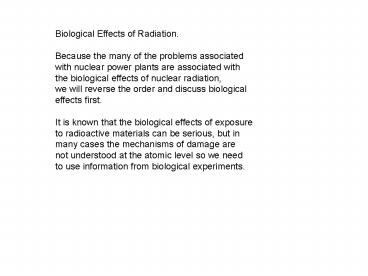Biological Effects of Radiation' - PowerPoint PPT Presentation
1 / 22
Title:
Biological Effects of Radiation'
Description:
It is known that the biological effects of exposure ... effects on biological. organisms including ... Much the biggest biological threat to human health ... – PowerPoint PPT presentation
Number of Views:1109
Avg rating:3.0/5.0
Title: Biological Effects of Radiation'
1
Biological Effects of Radiation. Because the
many of the problems associated with nuclear
power plants are associated with the biological
effects of nuclear radiation, we will reverse the
order and discuss biological effects first. It
is known that the biological effects of
exposure to radioactive materials can be serious,
but in many cases the mechanisms of damage
are not understood at the atomic level so we
need to use information from biological
experiments.
2
Units. Unfortunately many units are used
to Describe radiation exposure Energy
exposure 1 rad 10-7 joules in 1 gram of
tissue Quality factor Takes account of the
fact that Different kinds of radiation have
different Biological effects 1 rem (Quality
factor)x 1 rad
3
Table 15-1, p. 505
4
Table 15-2, p. 506
5
Lethal Dose 50 Animals (including humans)
exposed to intense radiation become ill and die
of various diseases, mainly cancers. The deaths
may occur quickly or over many decades and
the responses are not the same for all
individuals. The mechanisms of damage are not
well understood and the available information is
from data from experiments. The data can be
arranged in a dose-response curve as shown on the
next slide
6
The dose at which 50 die is called
the lethal-dose 50
Fig. 15-2, p. 507
7
Unfortunately we do have such data for humans as
a result of the bombs dropped on Hiroshima and
Nagasaki in 1945. By following the histories of
24,000 people exposed to intense radiation in
those events, data including that displayed in
the following graph was obtained.
8
leukemia
Fig. 15-3, p. 508
9
Note that the numbers are per million
person years. This data implies 2 cases per
rem of radiation per million people per year for
leukemia. There is debate concerning whether
such high dose data can be extrapolated to
determine risks at low doses, but most
scientists believe that it can.
10
Background radiation In evaluating the risk of
nuclear power plants it is necessary to take into
account that humans are exposed to significant
nuclear radiation in the absence of power plants
or nuclear weapons. A summary appears on the
next slide.
11
Table 15-5, p. 514
12
These radiation exposures do have health effects.
Unless nuclear power significantly increases this
exposure it would be rational to worry first
about the other exposures. These include
particularly radon. Measures you can take to
protect yourself against excessive radon exposure
are discussed in your book. Current national
standards limit radiation exposure above
background to 100mrem/yr
13
Table 15-3, p. 508
14
- From these tables, what kinds of health effects
can - be expected from the average background exposure
- during a 70 year human life? (Assume QF1.)
- None b. blood changes. c. injury and disability
d. death - in 30 days
Table 15-3, p. 508
15
Answer 360 mrem/yr x(1/1000 rem/mrem) x (1/QF
(rad/rem)) X70 yr 2.52 rad Some effects!
16
Decay of Radon, naturally occurring in common
rocks
Fig. 15-5, p. 510
17
Medical Procedure exposures
Table 15-4, p. 514
18
Fig. 15-7, p. 512
19
Fig. 15-6, p. 511
20
Somatic and genetic damage The biological
effects discussed so far are to the individual
irradiated (somatic) There are also effects on
the descendants of the irradiated individuals
through damage to the DNA molecules which carry
genetic information. Such mutations are known to
be a major source of the variation which,
together with natural selection, drives
biological evolution. They occur
naturally, driven by the background
radiation. However most mutations fail (do not
produce improvements in survivability) and too
many mutations will threaten the survivability
of a species.
21
Exposures from various other hazards
above background Proposed standard for the
Yucca Mountain high level waste storage site
15mrem/yr for 10,000 years (may not be
achievable) Normal nuclear reactor operation for
electric power production 170 mrem/yr (federal
limit) Chernobyl (worst nuclear power
accident to date) 200 mSv .2 x100 rem/SV x
1000mrem/rem 20,000mrem Nuclear bomb
Exposures and Hiroshima and Nagasaki were (for
survivors) from 100-500 rads 100,000-500,000
mrem ( if QF1 bone marrow only)
22
Summary and conclusions Radiation from
radioactive (decaying) nuclei has mainly
deleterious effects on biological organisms
including humans. Humans are all exposed to
substantial, naturally occuring radiation, most
significantly from radon. Much the biggest
biological threat to human health from nuclear
radiation arising from human activity is from
nuclear weapons, if they are ever used
again. The other dangers are from nuclear power
plant accidents and extremely long term storage
of nuclear waste. The federal limit on
exposure from normally operating nuclear power
plants Is about 20 above normal background.































